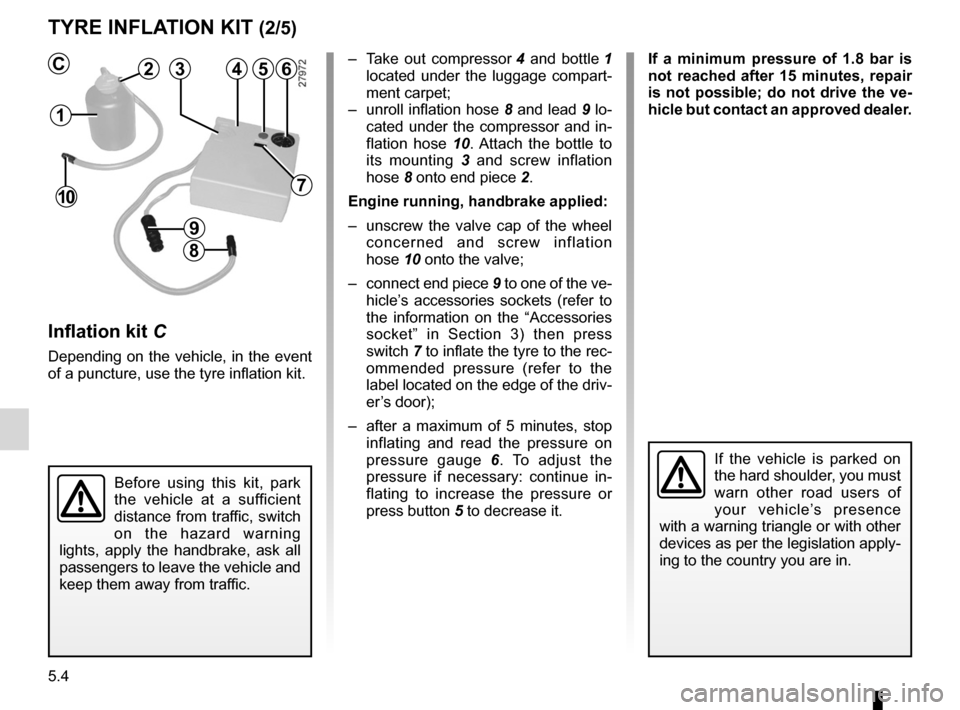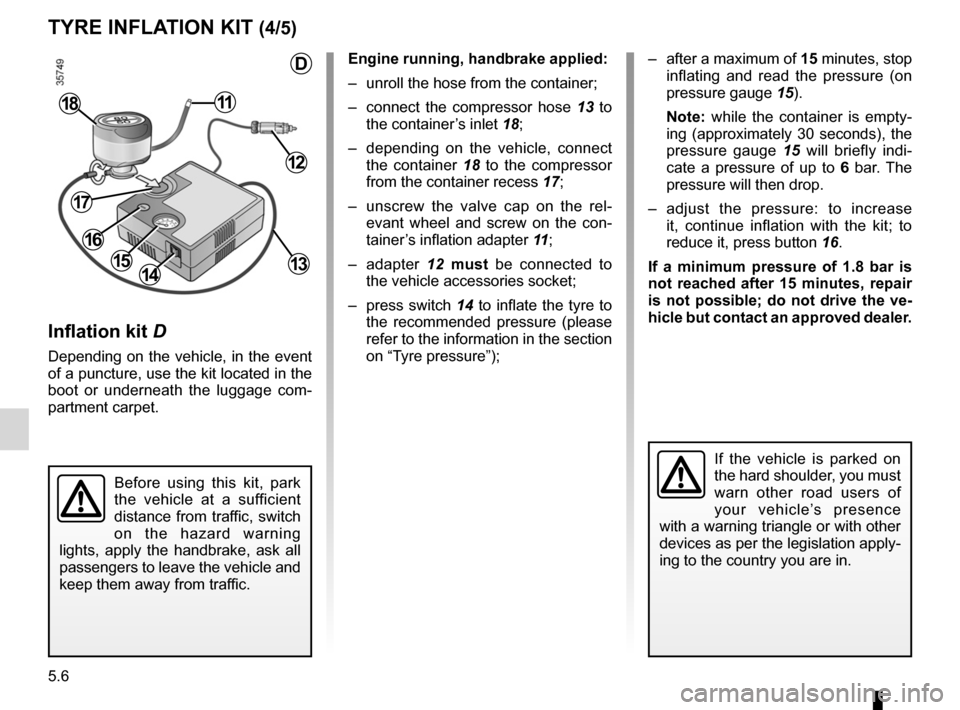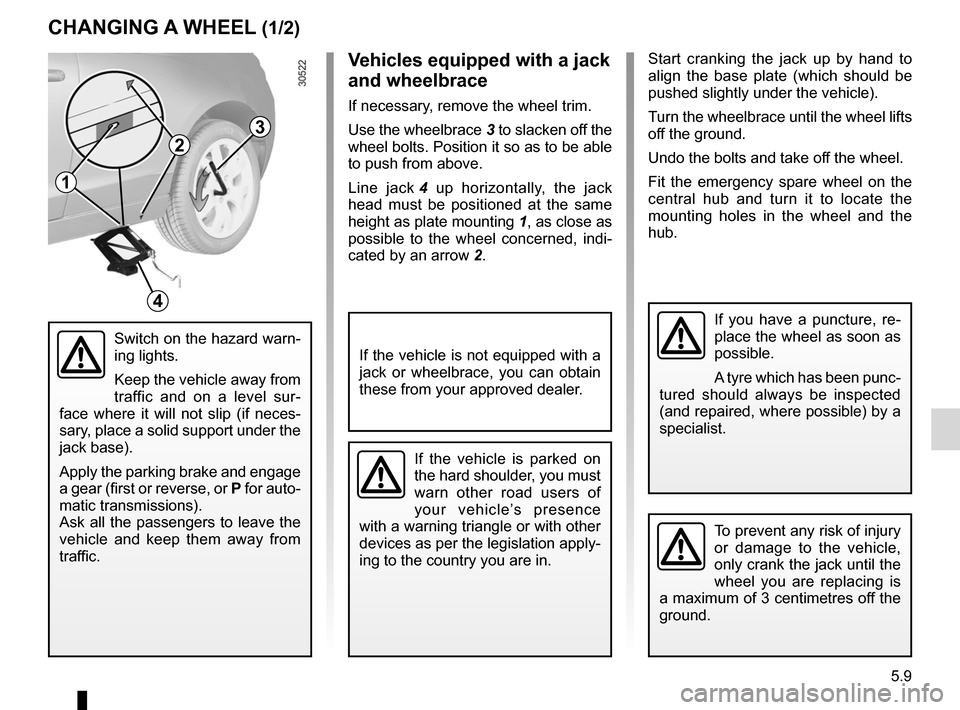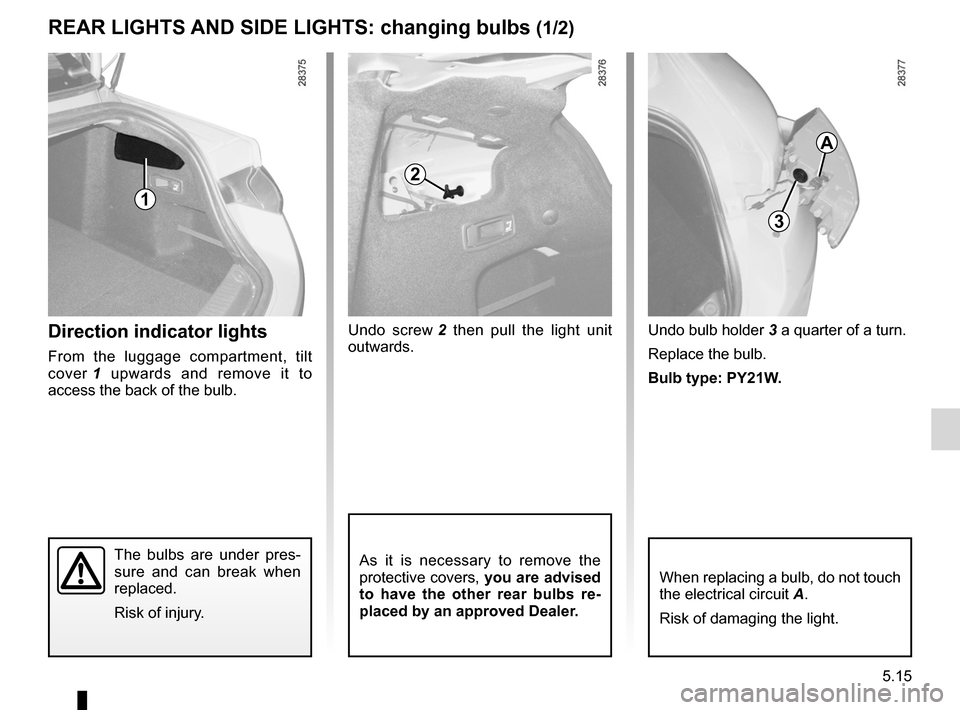2012 RENAULT LAGUNA COUPE brake light
[x] Cancel search: brake lightPage 145 of 221

4.1
ENG_UD29930_4
Sommaire 4 (X91 - D91 - Renault)
ENG_NU_939-3_D91_Renault_4
Section 4: Maintenance
Bonnet . . . . . . . . . . . . . . . . . . . . . . . . . . . . . . . . . . . . . . . . . . . . . . . . . . . . . . . . . . . . . . . . . . . . . . . . 4.2
Engine oil level: . . . . . . . . . . . . . . . . . . . . . . . . . . . . . . . . . . . . . . . . . . . . . . . . . . . . . . . . . . . . . . . . . 4.4
general information . . . . . . . . . . . . . . . . . . . . . . . . . . . . . . . . . . . . . . . . . . . . . . . . . . . . . . . . 4.4
Engine oil level: topping up, filling . . . . . . . . . . . . . . . . . . . . . . . . . . . . . . . . . . . . . . . . . . . . . . . . . . . 4.6
Engine oil change . . . . . . . . . . . . . . . . . . . . . . . . . . . . . . . . . . . . . . . . . . . . . . . . . . . . . . . . . . . . . . . 4.7
Levels: . . . . . . . . . . . . . . . . . . . . . . . . . . . . . . . . . . . . . . . . . . . . . . . . . . . . . . . . . . . . . . . . . . . . . . . . 4.8
engine coolant . . . . . . . . . . . . . . . . . . . . . . . . . . . . . . . . . . . . . . . . . . . . . . . . . . . . . . . . . . . . 4.8
brake fluid . . . . . . . . . . . . . . . . . . . . . . . . . . . . . . . . . . . . . . . . . . . . . . . . . . . . . . . . . . . . . . . . 4.9
windscreen/headlight washer reservoir . . . . . . . . . . . . . . . . . . . . . . . . . . . . . . . . . . . . . . . . . 4.10
Filters . . . . . . . . . . . . . . . . . . . . . . . . . . . . . . . . . . . . . . . . . . . . . . . . . . . . . . . . . . . . . . . . . . . . . . . . . 4.10
Tyre pressure. . . . . . . . . . . . . . . . . . . . . . . . . . . . . . . . . . . . . . . . . . . . . . . . . . . . . . . . . . . . . . . . . . . 4.11
Battery . . . . . . . . . . . . . . . . . . . . . . . . . . . . . . . . . . . . . . . . . . . . . . . . . . . . . . . . . . . . . . . . . . . . . . . . 4.12
Bodywork maintenance . . . . . . . . . . . . . . . . . . . . . . . . . . . . . . . . . . . . . . . . . . . . . . . . . . . . . . . . . . . 4.14
Interior trim maintenance . . . . . . . . . . . . . . . . . . . . . . . . . . . . . . . . . . . . . . . . . . . . . . . . . . . . . . . . . . 4.16
Page 153 of 221

brake fluid .............................................................. (current page)
levels: brake fluid ........................................................ (current page)
tanks and reservoirs brake fluid ........................................................ (current page)
JauneNoirNoir texte
4.9
ENG_UD29101_2
Niveaux (X91 - D91 - Renault)
ENG_NU_939-3_D91_Renault_4
brake fluid
LeVeLS (continued)
Brake fluid level
This should be checked frequently,
and immediately if you notice even the
slightest loss in braking efficiency. Level 1
It is normal for the level to drop as the
brake shoes become worn, but it must
never drop lower than the
“MIN" warn-
ing line.
If you wish to check the disc and drum
wear yourself, you should obtain the
document explaining the checking pro-
cedure from our network or from the
manufacturer’s website. t
opping up
After any operation on the hydraulic cir-
cuit, a specialist must replace the fluid.
Only use fluids approved by our
Technical Department (and taken from
a sealed container).
Replacement intervals
Refer to the Maintenance Document for
your vehicle.
1
The engine may be hot
when carrying out opera -
tions in close proximity. In
addition, the engine cooling
fan can come on at any moment.
Risk of injury.
Page 166 of 221

5.4
ENG_UD29151_1
Kit de gonflage des pneumatiques (X91 - B91 - K91 - D91 - Renault)
ENG_NU_939-3_D91_Renault_5
Jaune NoirNoir texte
tYre InFLA tIOn KIt (2/5)
Inflation kit C
Depending on the vehicle, in the event
of a puncture, use the tyre inflation kit.
– Take out compressor 4 and bottle 1
located under the luggage compart-
ment carpet;
– unroll inflation hose 8 and lead 9 lo-
cated under the compressor and in-
flation hose 10 . Attach the bottle to
its mounting 3 and screw inflation
hose 8 onto end piece 2.
engine running, handbrake applied:
– unscrew the valve cap of the wheel
concerned and screw inflation
hose 10 onto the valve;
– connect end piece 9 to one of the ve-
hicle’s accessories sockets (refer to
the information on the “Accessories
socket” in Section 3) then press
switch 7 to inflate the tyre to the rec-
ommended pressure (refer to the
label located on the edge of the driv-
er’s door);
– after a maximum of 5 minutes, stop
inflating and read the pressure on
pressure gauge 6 . To adjust the
pressure if necessary: continue in -
flating to increase the pressure or
press button 5 to decrease it. If a minimum pressure of 1.8 bar is
not reached after 15 minutes, repair
is not possible; do not drive the ve-
hicle but contact an approved dealer.
Before using this kit, park
the vehicle at a sufficient
distance from traffic, switch
on the hazard warning
lights, apply the handbrake, ask all
passengers to leave the vehicle and
keep them away from traffic.
1
23456
7
8
9
10
If the vehicle is parked on
the hard shoulder, you must
warn other road users of
your vehicle’s presence
with a warning triangle or with other
devices as per the legislation apply-
ing to the country you are in.
c
Page 168 of 221

5.6
ENG_UD29151_1
Kit de gonflage des pneumatiques (X91 - B91 - K91 - D91 - Renault)
ENG_NU_939-3_D91_Renault_5
Jaune NoirNoir texte
tYre InFLA tIOn KIt (4/5)
Inflation kit D
Depending on the vehicle, in the event
of a puncture, use the kit located in the
boot or underneath the luggage com -
partment carpet.
engine running, handbrake applied:
– unroll the hose from the container;
– connect the compressor hose 13 to
the container’s inlet 18;
– depending on the vehicle, connect
the container 18 to the compressor
from the container recess 17;
– unscrew the valve cap on the rel -
evant wheel and screw on the con -
tainer’s inflation adapter 11;
– adapter 12 must be connected to
the vehicle accessories socket;
– press switch 14 to inflate the tyre to
the recommended pressure (please
refer to the information in the section
on “Tyre pressure”);
1415
11
Before using this kit, park
the vehicle at a sufficient
distance from traffic, switch
on the hazard warning
lights, apply the handbrake, ask all
passengers to leave the vehicle and
keep them away from traffic.
18
If the vehicle is parked on
the hard shoulder, you must
warn other road users of
your vehicle’s presence
with a warning triangle or with other
devices as per the legislation apply-
ing to the country you are in.
– after a maximum of 15 minutes, stop
inflating and read the pressure (on
pressure gauge 15).
n ote: while the container is empty -
ing (approximately 30 seconds), the
pressure gauge 15 will briefly indi -
cate a pressure of up to 6 bar. The
pressure will then drop.
– adjust the pressure: to increase
it, continue inflation with the kit; to
reduce it, press button 16.
If a minimum pressure of 1.8 bar is
not reached after 15 minutes, repair
is not possible; do not drive the ve-
hicle but contact an approved dealer.
12
13
17
16
D
Page 171 of 221

changing a wheel.................................. (up to the end of the DU)
puncture ................................................ (up to the end of the DU)
lifting the vehicle changing a wheel ............................ (up to the end of the DU)
5.9
ENG_UD19884_6
Changement de roue (X91 - D91 - Renault)
ENG_NU_939-3_D91_Renault_5
If the vehicle is parked on
the hard shoulder, you must
warn other road users of
your vehicle’s presence
with a warning triangle or with other
devices as per the legislation apply-
ing to the country you are in.
Start cranking the jack up by hand to
align the base plate (which should be
pushed slightly under the vehicle).
Turn the wheelbrace until the wheel lifts
off the ground.
Undo the bolts and take off the wheel.
Fit the emergency spare wheel on the
central hub and turn it to locate the
mounting holes in the wheel and the
hub.
Changing a wheel
cHAnGInG A WHeeL (1/2)
Vehicles equipped with a jack
and wheelbrace
If necessary, remove the wheel trim.
Use the wheelbrace 3 to slacken off the
wheel bolts. Position it so as to be able
to push from above.
Line jack 4 up horizontally, the jack
head must be positioned at the same
height as plate mounting 1, as close as
possible to the wheel concerned, indi -
cated by an arrow 2.
3
4
Switch on the hazard warn-
ing lights.
Keep the vehicle away from
traffic and on a level sur -
face where it will not slip (if neces -
sary, place a solid support under the
jack base).
Apply the parking brake and engage
a gear (first or reverse, or P for auto-
matic transmissions).
Ask all the passengers to leave the
vehicle and keep them away from
traffic.
1
2
To prevent any risk of injury
or damage to the vehicle,
only crank the jack until the
wheel you are replacing is
a maximum of 3 centimetres off the
ground.
If you have a puncture, re -
place the wheel as soon as
possible.
A tyre which has been punc-
tured should always be inspected
(and repaired, where possible) by a
specialist.
If the vehicle is not equipped with a
jack or wheelbrace, you can obtain
these from your approved dealer.
Page 177 of 221

bulbschanging ......................................... (up to the end of the DU)
changing a bulb .................................... (up to the end of the DU)
lights: direction indicators ........................................... (current page)
lights: side lights ......................................................... (current page)
lights: brake lights ...................................................... (current page)
lights: reversing lights ................................................. (current page)
lights: fog lights .......................................................... (current page)
indicators: direction indicators ........................................... (current page)
bulbs changing ......................................... (up to the end of the DU)
5.15
ENG_UD22250_4
Feux arrière et latéraux : remplacement des lampes (X91 - D91 - R\
enault)
ENG_NU_939-3_D91_Renault_5
Rear lights and side lights (changing bulbs)
reAr LIGHtS AnD SIDe LIGHtS: changing bulbs (1/2)
2
1
3
Undo screw 2 then pull the light unit
outwards.Direction indicator lights
From the luggage compartment, tilt
cover 1 upwards and remove it to
access the back of the bulb.
The bulbs are under pres -
sure and can break when
replaced.
Risk of injury.As it is necessary to remove the
protective covers, you are advised
to have the other rear bulbs re -
placed by an approved Dealer.
Undo bulb holder 3 a quarter of a turn.
Replace the bulb.
Bulb type: PY21W.
When replacing a bulb, do not touch
the electrical circuit A.
Risk of damaging the light.
A
Page 182 of 221

5.20
ENG_UD22226_3
Fusibles (X91 - D91 - Renault)
ENG_NU_939-3_D91_Renault_5
FuSeS (2/2)
Some accessories are protected by
fuses located in the engine compart -
ment in fuse box A.
However, because of their reduced ac-
cessibility, we advise you to have your
fuses replaced by an approved Dealer.
A
Allocation of fuses (DePenDInG On tHe eQuIPMent LeVeL)
Symbol Allocation SymbolAllocation
ZInterior lightingRadio amplifier
Interior rear-view mirrorîRadio
CHeated rear screenaInstrument panel
ÌHornnDriving correction devices
Child safetyElectric seats
DIndicatorëAccessories sockets
Electric windowsyVentilation
ñHeated seatstAir conditioning
ERear screen wiperÆCigar lighter
[SunroofHeating system
Electronic parking brakeHWindscreen washer
ÝTowing equipment supply
Page 188 of 221

towingbreakdown ...................................... (up to the end of the DU)
towing hitch ........................................... (up to the end of the DU)
5.26
ENG_UD29837_5
Remorquage : dépannage (X91 - D91 - Renault)
ENG_NU_939-3_D91_Renault_5
Jaune NoirNoir texte
Before towing, unlock the steering
column: with the clutch depressed,
engage first gear (lever in position n
or r for vehicles with automatic trans -
missions), insert the RENAULT card in
the card reader then press the engine
start button for two seconds.
The column is unlocked, the acces -
sory functions are supplied: the vehi -
cle lights can be used (indicators, brake
lights etc.). At night the vehicle must
have its lights on.
Once you have finished towing, press
the engine start button twice (risk of
running down the battery).
The speed specified by current legis -
lation for towing must always be ob -
served. If your vehicle is the towing
vehicle, do not exceed the maximum
towing weight for your vehicle (refer
to the information on “Weights” in
Section 6).
Towing
tOWInG : breakdown
towing a vehicle with an
automatic gearbox
With the engine switched off, the trans-
mission is no longer lubricated. It is
preferable to tow this type of vehicle on
a trailer or tow it with the front wheels
off the ground.
u nder exceptional circumstances ,
you may tow the vehicle with all four
wheels on the ground, only going for -
ward, with the gear lever in the n posi-
tion, and for a distance not exceeding
30 miles (50 km).
– Use a rigid towing bar.
If a rope or cable is used
(where the law allows this),
the vehicle being towed
must be able to brake.
– A vehicle must not be towed if it is
not fit to be driven.
– Avoid accelerating or braking
suddenly when towing, as this
may result in damage being
caused to the vehicle.
– When towing a vehicle, it is ad -
visable not to exceed 15 mph
(25 km/h).
1
D o n o t r e m o v e t h e
RENAULT card from the
reader when the vehicle is
being towed.
If the lever is stuck in P,
even though you are de -
pressing the brake pedal,
the lever can be released
manually. To do this, insert a rigid
rod in the hole 1, press the rod and
unlocking button located on the gear
lever knob simultaneously.